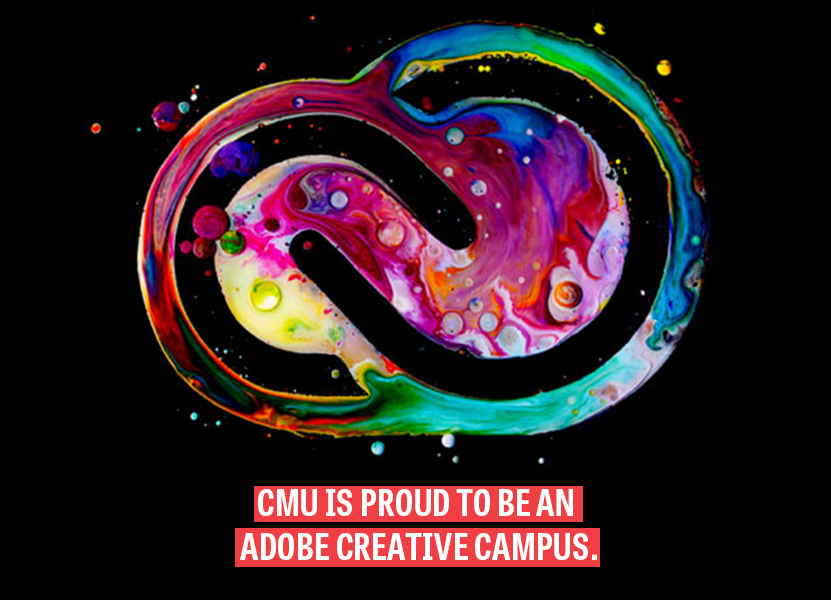Historically, Adobe software has been thought of as used only by those studying and working within media-rich and creative fields – art, graphic design, journalism, video production, animation, web design, etc. You know, by the creative people. While that may have been true in the past, it is far from so in 2021. In today’s workplace, it is more important than ever for both newcomers and long-time workers to sharpen and grow their creative skills. In fact, creativity is one of the most common components of current, and surely future, job descriptions. Tech savviness, communication, digital media skills, and continuous learning also rank very high.
In the Fall of 2020, with a goal of increasing digital literacy and creativity across all curriculums and the workplace, CMU became an Adobe Creative Campus. This means that all students, faculty, and staff have access to the entire collection of Adobe Creative Cloud applications, regardless of which college, program, or department they are studying or working within. The American Library Association defines digital literacy as “the ability to use information and communication technologies to find, evaluate, create, and communicate information, requiring both cognitive and technical skills.”
Consider for a moment how inundated our daily lives are by multimedia. Everywhere you turn, you see and hear images, graphics, audio, video, animations, and more within print and electronic forms. While the written, spoken, and typed word has long been and will continue to be incredibly powerful, when it is accompanied by multimedia, the impact can grow exponentially. The more of these skill sets that an individual can obtain, the more appealing they will be to their current and future employers. Access to Adobe software allows students in all disciplines to explore their creative side, obtain new skills, and be creative in their course work. It provides faculty and staff with another tool to utilize as part of their teaching, research, and workplace projects.
Imagine, if you will, a term paper about social justice that is also accompanied by photos, a snippet of video from a recent event, and an information graphic that helps simplify complex statistics. What if this was the norm and expectation and not the exception? The student who makes all of this happen will be appealing to future employers. Consider a faculty member who needs to record, edit, and produce audio interviews with subject matter experts as part of a research study and is then able to turn them into podcasts. What about a staff member who needs to create social media content to promote an upcoming event? All of this and more are possible with access to little more than an idea, a computer, and Adobe software. As necessary and appropriate, the needs and interests of users will define what level of awareness, competency, proficiency, or fluency are required to learn and implement various software and hardware.
A committee comprised of stakeholders from various organizations and demographics across the University, including a number of Library staff members, has been hard at work for more than a year on various aspects of the Adobe Creative Campus initiative. Several Library staff members have played key roles in the development of a web site, planning of services and support efforts, and the creation of the Adobe Digital Lounge, which is scheduled to open in the Fall 2021. This space is being built out on the second floor of Park Library and will include flexible seating, a presentation space, an audio recording studio, big screens, and more. Students and professional staff will be available to assist users with whatever creative endeavors they are interested in exploring. In time, specialized hardware such as a cameras, microphones, and the like will be available for check out. Adobe Creative Cloud software is already available on all public workstations within the Library.
In February, the Library Professional Development Committee hosted a webinar that provided an overview of the Adobe Creative Campus initiative, a tour of Adobe Creative Cloud, and a show-and-tell demonstration of a highly versatile and introductory multimedia tool called Adobe Spark. At the end of the session, participants were pitched a challenge to get creative with a project of their own – professional, academic, or personal – within two weeks of the webinar. As anticipated, they hit it out of the park! (See what we did there? Park. Park Library? Sorry, just trying to be creative.) You can view the work and read about the experiences of our incredibly talented and creative staff by visiting the CMU Libraries Do Creativity portfolio.
We are excited about the future of the Adobe Creative Campus initiative and the Libraries’ role within it. We also look forward to sharing the knowledge, skills, and creativity of other members of the University community.
By: Brian A. Roberts, Manager of Technology Awareness and Training, Information Technology & Library Systems Team

